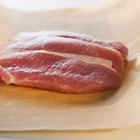
Butterflying is a butchering technique that lets you enhance the taste of your roast with a myriad of additional flavors. When you butterfly, you cut the meat horizontally, leaving the halves attached by a thin strip of meat. Because pork tenderloin is a small, generally 1 1/2- to 2-pound roast, when butterflied it is often rolled in a spiral around a moist fruit or vegetable stuffing, and oven-roasted.
Simple Roast
Step 1
Lay the roast on a cutting board, and trim any fat or silverskin membrane with the knife, taking care not to cut holes in the meat.
Step 2
Position your knife blade parallel to the cutting board. Cut the roast horizontally in half, leaving the top and bottom connected by a strip of meat 1/2 inch wide. Dry the roast and cutting board with paper towels.
Step 3
Brush a casserole dish or shallow baking pan with 1 tablespoon of olive oil, and lay the meat, cut side up, in the pan. If desired, lay a bed of chunked root vegetables inside the dish, drizzle the veggies with balsamic vinegar, then lay the meat on top of them.
Step 4
Brush the top surface of the meat with another tablespoon of oil, and sprinkle it with your desired seasonings.
Step 5
Place your tenderloin in an oven preheated to 425 degrees Fahrenheit, or 350 F if you've included vegetables. Roast the meat until an instant-read thermometer inserted into the thickest part of the meat reads 145 F. A whole tenderloin weighing 1 1/2 pounds will take approximately 30 minutes to reach this temperature. Begin checking your butterflied roast at 20 minutes to avoid overcooking. Allow the meat to rest for 3 minutes.
Stuffed Tenderloin
Step 1
Preheat the oven to 350 F.
Step 2
Butterfly your tenderloin. Position your knife blade parallel to the cutting board. Cut the roast horizontally in half, leaving the top and bottom connected by a strip of meat 1/2 inch wide. Dry the roast and cutting board with paper towels.
Step 3
Lay the roast cut side up on the board, and spread a layer of stuffing within 1/2 inch of all edges. Your stuffing can include things like spinach and cheese, or tomatoes and herbs. Any meat in your stuffing should already be cooked through before spreading it onto your tenderloin.
Step 4
Gently roll the meat away from you, starting with the long side of the meat closest to you, creating a spiral roll. Use gentle pressure to create a snug roll, but do not push hard enough that stuffing leaks out of the ends.
Step 5
Secure the outermost edge of the spiral to the roll temporarily with wooden toothpicks or small metal skewers, if you wish, for ease.
Step 6
Move the rolled tenderloin to one edge of the cutting board. Cut 12-inch lengths of butcher's twine, enough to make ties every 2 inches down the length of the roast. For a 16-inch tenderloin, for example, you would need 7 lengths of string. Lay the strings at 2-inch intervals across the board, and center the roast on top of them. Tie firmly, and remove toothpicks or skewers, if used.
Step 7
Pour 1 to 2 tablespoons of oil into a heavy-bottomed casserole or skillet. Brown the tenderloin on all sides over medium-high heat.
Step 8
Move the skillet to the oven, or transfer the roast from the skillet to a lightly-oiled roasting pan, and place it in the oven.
Step 9
Begin checking the roast after 10 minutes. Once the meat's internal temperature registers 145 F, it's ready to come out. Insert the thermometer into the meat at the center of the spiral for the most accurate reading.
Step 10
Let the roast rest for 3 minutes before cutting the strings and serving.
Related Articles

How to Cook Tender Rolled Flank Steaks ...

How to Make quick Meat Loaf

How to Make a Juicy Pork Tenderloin

Roasting Instructions for a Half Loin ...

How to Slow-Cook Meat in the Oven

How to Cook Bacon-Wrapped Beef Chuck ...

How to Cook Pancetta

How to Cook an 8- to 10-Pound Beef ...

How to Cook Pork Pinwheels

How to Cook Stuffed Flank Steak With ...

How to Fry Cauliflower Patties

How to Cook the Neck of a Deer

How to Freeze Stromboli

How to Wrap Hair Without Breakage

How to Cook Bacon-Wrapped Deer Loin

How to Convection Roast a Brisket

How to Cook a Rib Eye to Medium-Well in ...

How to Cook Beef Topside in a Slow ...

How to Soak Deer Meat in Baking Soda

How to Roast Italian Sausage
References
Tips
- The 3-minute rest period for pork roasts is an integral part of the most recent food-safety guidelines, issued by the USDA in the early 1990s. Letting the roast sit assures a long enough period at maximum internal temperature to kill any possible pathogens. The rest period also lets meat juices resettle into tissues after cooking, making your roast moist and tender.
- Recipes published before the 1990s may specify cooking times based on a safe internal temperature of 160 F.
Writer Bio
Janet Beal has written for various websites, covering a variety of topics, including gardening, home, child development and cultural issues. Her work has appeared on early childhood education and consumer education websites. She has a Bachelor of Arts in English from Harvard University and a Master of Science in early childhood education from the College of New Rochelle.
Photo Credits
Jupiterimages/Stockbyte/Getty Images